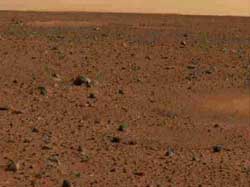NASA shows off Spirit's 'post card' from Mars
( 2004-01-07 09:16) (Agencies)
NASA scientists have shown off their first colour "post card" of Mars taken by the robot explorer Spirit, a high-definition portrait revealing the rocky, wind-swept surface of the red planet in greater detail than ever seen before.
The photograph -- actually a mosaic of a dozen three-colour frames shot by Spirit's twin panoramic cameras -- showed a barren, burnt-orange landscape strewn with blue-grey rocks stretching to the edge of a butterscotch horizon.
 |
| The first 3-D stereo image from the Mars Exploration Rover's navigation camera, showing only the view from the left stereo camera aboard the Mars Exploration Rover Spirit, was released by the Jet Propulsion Laboratory in Pasadena, California, on Tuesday. The left and right camera images are combined to produce a 3-D image. [Reuters/NASA] |
The picture brought into focus such vivid details as the shape and texture of rocks, deposits of pebbles scattered by winds, powder-filled hollows, soil trails left by dust devils, nearby hills, and a tantalising but distant mesa.
One of the most intriguing features noticed by scientists was a darkened patch of the Martian surface at the edge of the lander, where the soil had been scraped by Spirit's air bags, leaving a crinkled pattern with a mud-like cohesive appearance.
"It looks like mud but it can't be mud," said Steven Squyres, the principal investigator for the team at NASA's Jet Propulsion Laboratory, on Tuesday. "It's very cohesive. It holds together well."
The picture also revealed that the surface of the rocks surrounding Spirit in its landing site at Gusev Crater appeared to have been worn clean by the sand-blasting effects of high winds. The rocks varied widely in size and shape, some of them rounded, some angular. A close-up of one small rock showed it to be pitted with tiny craters of its own.
SHARPER IMAGE
Jim Bell, the team's leading camera specialist, said the "post card" image was 16 times higher resolution than the earlier black-and-white panoramic photos taken by Spirit's navigation cameras and three to four times sharper than the best pictures ever shot on Mars before, those taken by the Mars Pathfinder mission in 1997.
Still, scientists said the best is yet to come. Tuesday's 12-million-pixel photo, though higher definition than earlier pictures, represents about one-eighth of the entire 360-degree panorama that the twin pan cams are capable of shooting.
In a matter of days, the JPL teams expects to acquire a full 360-degree shot in three-dimensional, four-colour, splendour, Bell said.
"This is just the tip of the iceberg," Squyres added.
Still a mystery is the composition of the terrain in Gusev, a giant basin that scientists believe may be the site of an ancient lake bed.
JPL's team of geologists will glean more information as they begin surveying the landscape with an instrument called the mini-thermal emission spectrometer, or "Mini-Tes", which reads infrared radiation emitted by rocks to determine their mineral makeup.
The JPL team is even more eager to get Spirit off its landing pad and roaming its environs, allowing scientists to closely examine soil and rocks using a collection of high-tech geologic gadgets carried on the rover's robot arm.
ANTENNA GLITCH
In a mission that has been remarkably problem free, one glitch has been difficulty in pointing the craft's main antenna at Earth to establish a direct, higher-speed communications link. So far, pictures and other data have been beamed at intervals by a smaller antenna to one of two Mars orbiters as they pass overhead.
Early data received from Spirit showed spikes in electrical current indicating that the elevation driver of the main antenna may be "a little sticky," said Jennifer Trosper, mission manager for surface operations. But the fluctuations may turn out to come from an instrument flaw rather than an actual mechanical problem.
After Spirit awakens to its third Martian day, or sol, late Tuesday, mission managers said they would work to retract a partially inflated air bag that stands in Spirit's exit path. On day four, they plan to lift the folded, six-wheeled rover off of its belly and begin stretching out its legs.
|

